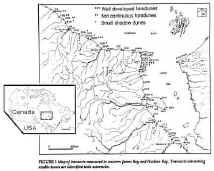Proceedings Candian Symposium on Coastal Sand Dunes 1990, 137-157
AEOLIAN FEATURES OF THE RECENT, SUBARCTIC COASTAL ZONE OF THE HUDSON BAY
LOWLAND, ONTARIO, CANADA
I.P. MARTINI
Department of Land Resource Science, University of Guelph, Guelph, Ont. NlG
2Wl
¡¡
 On the tectonically stable, flat, open, subarctic, emerging coastal areas of
the Hudson Bay Lowland modern sediments are derived from cannibalization of
relatively thin Pleistocene drift and glacio-marine mud. A change occurs from
absence of dunes in southern James Bay, to some partially deflated foredunes on
the slightly sandier and more exposed coasts of subarctic northern James Bay, to
low but well developed foredunes on the open beach ridges of southwestern Hudson
Bay. Some beach ridges develop few, low, discontinuous shadow dunes in the lee
of gravel clusters or of sparse grassy vegetation clumps; others develop sizable
foredunes on the active ridge. The active tidal flat-beach-foredunes links show
a gradation from sandy intertidal areas, to wide deflated frontal part of beach
ridges, to low shadow foredunes anchored by clumps of Honkenia peploides,
up into higher foredunes colonized by Elymus mollis. Numerous, shallow,
pits dot the landward facing precipitation slopes of foredunes, dug by polar
bears during the summer. Some of the pits breach the dune crests and develop
into blowouts. The dunes become deflated as the land emerges and they are cut
off from the sandy beach source. Dissected, star shaped, 3-5 m high dune
remnants occur isolated over wide, flat, deflated, pebble armoured, exhumed
beach ridge surfaces. Low vegetation patches trap some sand on the deflated
surface imparting characteristic microtopography to it. Few low mounds or thin
patches of sand are preserved under tundra which, farther inland (south), is
replaced by fens, bogs or coniferous forests. Another byproduct of intense
periods of deflation or farther inland where the vegetative protection is
disrupted by fires, is the formation of thin, sorted sandy laminae in peat
sequences which develop in inter-ridge areas.
On the tectonically stable, flat, open, subarctic, emerging coastal areas of
the Hudson Bay Lowland modern sediments are derived from cannibalization of
relatively thin Pleistocene drift and glacio-marine mud. A change occurs from
absence of dunes in southern James Bay, to some partially deflated foredunes on
the slightly sandier and more exposed coasts of subarctic northern James Bay, to
low but well developed foredunes on the open beach ridges of southwestern Hudson
Bay. Some beach ridges develop few, low, discontinuous shadow dunes in the lee
of gravel clusters or of sparse grassy vegetation clumps; others develop sizable
foredunes on the active ridge. The active tidal flat-beach-foredunes links show
a gradation from sandy intertidal areas, to wide deflated frontal part of beach
ridges, to low shadow foredunes anchored by clumps of Honkenia peploides,
up into higher foredunes colonized by Elymus mollis. Numerous, shallow,
pits dot the landward facing precipitation slopes of foredunes, dug by polar
bears during the summer. Some of the pits breach the dune crests and develop
into blowouts. The dunes become deflated as the land emerges and they are cut
off from the sandy beach source. Dissected, star shaped, 3-5 m high dune
remnants occur isolated over wide, flat, deflated, pebble armoured, exhumed
beach ridge surfaces. Low vegetation patches trap some sand on the deflated
surface imparting characteristic microtopography to it. Few low mounds or thin
patches of sand are preserved under tundra which, farther inland (south), is
replaced by fens, bogs or coniferous forests. Another byproduct of intense
periods of deflation or farther inland where the vegetative protection is
disrupted by fires, is the formation of thin, sorted sandy laminae in peat
sequences which develop in inter-ridge areas.